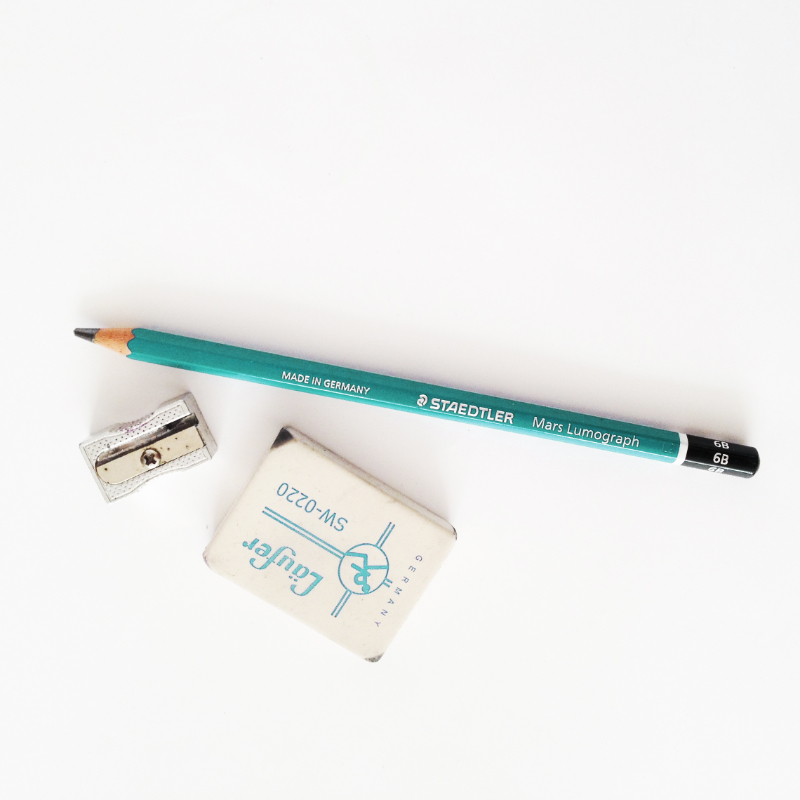getting over your fear of drawing

So many of us regularly feel an impulse to create, to make something with our hands, but never act on it. What’s stopping us?
I think a big part of it is fear. Although it may sound strange to some, taking the step to create something can be super scary. There’s all sorts of emotions that come into play. Hopes for what you’ll create, self-expectations, perceived expectations from others. When you make something, you put yourself out there. You’re creating something deeply personal, and making it visible for others to judge. It gets even more complicated if you have been told at a young age that you’re “just not good at art”. Or if you had a sibling who was labeled “the creative one”. Perfectionism and fear of failure can have a crippling effect.
So how do you beat the fear of drawing?
Feel the fear
It all starts easy enough. In kindergarten or pre-school, no child’s creativity is questioned. Everyone gets a box of crayons. I’m pretty sure you didn’t fear your crayons then, so why do you now? Try to reconnect with how you felt about drawing as a kid. Remember the carelessness and joy you felt around creating. Can you recollect when and why you started to feel a sense of inhibition and worry about drawing?
It can be good to take a moment to really feel your fears, and name them. Writing your thoughts down takes some of their power away. For example, one of the following worries might go through your head: What if it turns out I’m no good at drawing? What if people will think I’m self-indulgent for wanting to explore my creativity? What if I’ll love drawing so much, I’ll want to turn my whole life around? Whatever the fear is for you, writing it down will help you to look at it objectively and realise that the answer to the what if? is probably not a huge deal. Drawing doesn’t actually pose a serious threat to life as you know it!
So if you have the desire to draw, you should absolutely do it. Here’s how:
Set yourself up for success
Preparation is everything. Each time you feel inspired or have an idea for a drawing, record it! Collect notes and inspirational images in a folder, or use a note-taking app like Evernote on your phone. This collection of ideas will become a valuable resource for those times when you just don’t know what to draw. Next, store your drawing supplies somewhere easily accessible. That way, you won’t have the excuse that it’s too much of a hassle to get your stuff together. Then clear out a specific time each day or each week for drawing. Start small, with maybe just half an hour. Sticking to it really helps in the long run, because any desired behaviour becomes easier when you make it into a habit.
Just begin
Now that you’re all set up, you’ll want to know how to start. This is the hardest part, with the simplest solution. You just have to begin! Don’t think about it too much. Your inner resistance has a way of making you believe that you ‘just don’t feel like drawing right now’. It is very important not to wait until you are in the right mood, because that almost never happens spontaneously. The lovely, wonderful feelings that come from drawing usually only start once you’re about 10 or 15 minutes in.
Sometimes, the idea of making a finished drawing can feel like too much of a commitment. When you feel that way, tell yourself: “I’m just going to draw for ten minutes. Then, I’ll see if I feel like continuing or not.” More often than not, you will end up drawing for much longer than the ten minutes you committed to. For those times when you’re feeling particularly scared, remind yourself that you’re not about to do brain surgery. You’re just going to put some graphite onto some paper. Or say out loud: “I am now going to make a very ugly drawing.” This helps to take the self-imposed pressure off.
Doing is better than not doing
Look, you are drawing! Wonderful! You can congratulate yourself on overcoming a serious fear. That is a big deal! Here are some ways to make the experience a positive one:
Inevitably there will be times when you feel stuck or frustrated with your drawing. The important thing is: don’t give up. It can help to get up for a bit, walk around the house, make a cup of tea. Then, when you come back to your drawing, you will clearly see what parts need changing. And as hard as it is (I know), try not to worry about what others might think of what you are creating. The truth is, most people are way too busy anyway worrying about their own lives, to care that much about your drawings. Your drawings are most important to you. Drawing should be something you do for yourself.
Finally, always remember that it’s totally ok to make some bad drawings, or a lot of bad drawings! Doing is already so much better than not doing, and the act of drawing is much, much more important than the result.
Connect
Send me an email
info@annemarieschumacher.com
Instagram @todrawistosee
Studio
Werkstatt 23
Schönwalder Straße 23
13347 Berlin-Wedding
